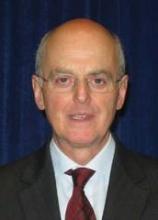SAN ANTONIO – A lower-dose, briefer radiotherapy regimen than is standard for early-stage breast cancer in the U.S. demonstrated comparable efficacy with fewer side effects at 10 years of follow-up in a pair of landmark U.K. studies.
"Long-term follow-up confirms that a lower total dose of radiation in fewer, slightly larger fractions delivered over a shorter treatment time is at least as safe and effective as standard 5-week schedules of curative radiotherapy in women with early breast cancer," Dr. John R. Yarnold declared in presenting the latest data from the U.K. START (Standardization of Breast Radiotherapy) trials at the annual San Antonio Breast Cancer Symposium.
The historical standard of care for radiotherapy in patients with surgically excised early breast cancer is 50 Gy delivered in 25 fractions of 2.0 Gy each over the course of 5 weeks. That’s still standard practice in the United States.
In the United Kingdom, however, the standard nationwide is 40 Gy in 15 fractions of 2.67 Gy over 3 weeks. Radiologists term this "hypofractionation": delivering a lower total dose of radiation using fewer but larger fractions. Hypofractionation has standard practice in the United Kingdom since the National Institute for Health and Clinical Excellence–issued guidelines to that effect in 2009. Those guidelines were based in large part on the earlier, highly favorable 5-year outcomes of START A (Lancet Oncology 2008;9:331-41) and START B (Lancet 2008;371:1098-107).
The START investigators deemed it essential to conduct the new 10-year analysis because adverse effects of radiotherapy given for breast cancer can arise after the 5-year mark. Also, it was important to learn whether the early antitumor effects of hypofractionated radiotherapy persisted, explained Dr. Yarnold, professor of clinical oncology at the Institute of Cancer Research, London.
The two key findings at the 10-year mark of START are, first, that both breast cancer and the dose-limiting normal tissues respond similarly to fraction size, so there’s no advantage in continuing the 2 Gy fractions that have historically been the international standard; and, second, that a 15-fraction/3-week schedule is gentler on normal tissues and comparable in antitumor efficacy to a 25-fraction/5-week regimen.
The clinical implications are clear, Dr. Yarnold emphasized: "Patients can safely be treated to a lower total dose with fewer fractions than the historical standard of 50 Gy and 25 fractions. There are no detrimental effects of hypofractionation noted in any of the subgroups studied."
The 10-year rate of moderate to marked adverse treatment effects on normal tissues in START A survivors who received 39 Gy in 13 fractions over 5 weeks was 43.9% compared with 50.4% in those randomized to 50 Gy in 25 fractions over 5 weeks. The resultant 20% relative risk reduction with a lower total radiation dose delivered in fewer fractions was statistically significant. In contrast, the 10-year locoregional tumor relapse rates in the two groups were similarly low.
At 10 years in START B, patients who received 40 Gy in 15 fractions over 3 weeks had a 37.9% rate of moderate-to-marked adverse effects on normal tissues, compared with a 45.3% rate in those who got 50 Gy in 25 fractions over 5 weeks, for a highly significant 23% risk reduction. The relapse rate was 4.3% after 40 Gy and 5.5% after 50 Gy, a nonsignificant difference.
In both trials, all types of side effects involving normal tissues were significantly less common in the lower-total-dose, fewer-fraction groups. That includes brachial plexus injury, which has been a concern expressed by supporters of the historical standard regimen, Dr. Yarnold added.
Radiologists and surgeons in the audience called the 10-year START results "very, very important" and likely to be practice changing.
Canada has already switched from the historical standard to 42.5 Gy delivered in 16 fractions over the course of 22 days. Asked if he thinks U.S. radiologists, too, should change their practice in light of the START findings, Dr. Yarnold was diplomatic. "I foresee no scientific reasons why they should not consider that very carefully," he replied.
Follow-up will continue in the START trials, which are funded by the Institute for Cancer Research, Cancer Research UK, the Medical Research Council, and the National Cancer Research Institute. Dr. Yarnold reported having no financial conflicts.

